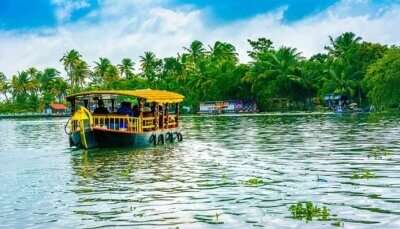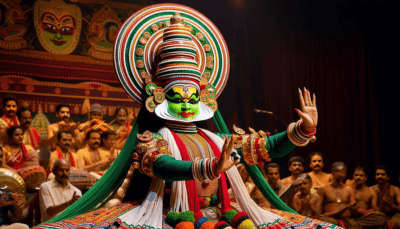Exploring Heritage And Faith At The Santa Cruz Cathedral Basilica In Kochi
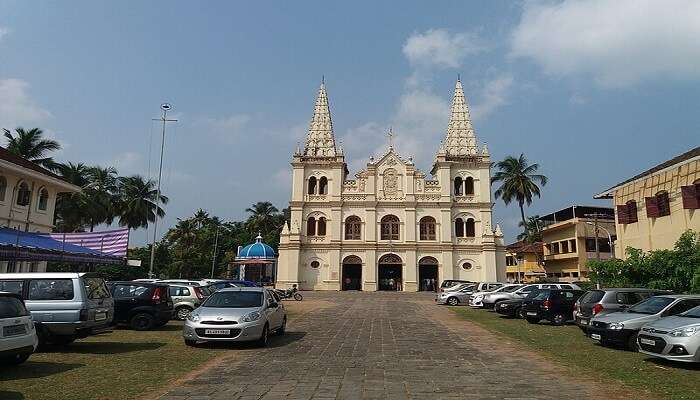
Nestled in the vibrant city of Kochi, the Santa Cruz Cathedral Basilica stands as a testament to the rich cultural and religious heritage of Kerala, India. This architectural marvel, with its stunning combination of Gothic and Indo-European styles, is more than just a place of worship—it is a symbol of resilience and history, having withstood the tests of time since its foundation in 1505. As one of the thirty-four basilicas in India, it attracts pilgrims, history enthusiasts, and tourists alike, offering a serene and awe-inspiring atmosphere. This article will delve into the captivating story of Santa Cruz Cathedral Basilica, exploring its historical significance, architectural grandeur, and the profound spiritual experience it offers to all who visit.
About Santa Cruz Cathedral Basilica
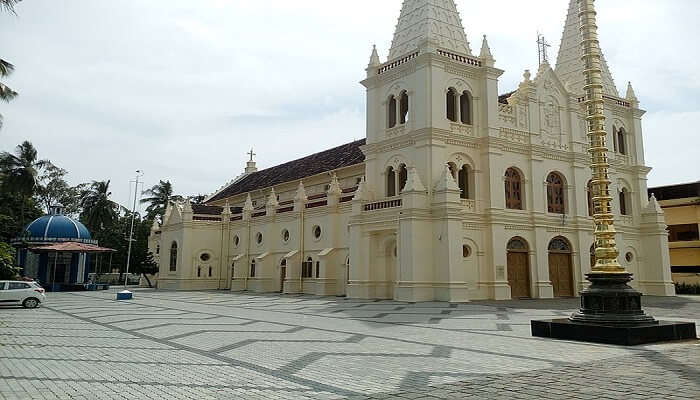
The Santa Cruz Cathedral Basilica, also known as Kotta Palli or Kottepalli, is a prominent landmark in Fort Kochi, Kochi. This distinguished basilica is among thirty-four basilicas in India and one of nine in the state of Kerala. Its architectural style reflects both Indo-European and Gothic influences, showcasing Kerala’s unique heritage.
Originally constructed by the Portuguese in 1505 with the consent of the King of Cochin, it gained status as a cathedral from Pope Paul IV in 1558. Despite the widespread destruction of Catholic structures by the Dutch during their arrival in the 17th century, the Santa Cruz Cathedral Basilica was spared. However, it faced demolition by the British in 1795. A new cathedral was later commissioned in 1887 under the guidance of Bishop João Gomes Ferreira of Cochin. This new structure was consecrated in 1905 and eventually bestowed with the title of a basilica by Pope John Paul II in 1984.
Today, the Santa Cruz Cathedral Basilica stands as one of India’s most splendid churches, drawing tourists from around the globe annually. Beyond its role as a place of worship, it serves as a testament to historical significance, boasting architectural and artistic magnificence that captivates visitors.
Also Read: Kathrikadavu
History of Santa Cruz Cathedral Basilica
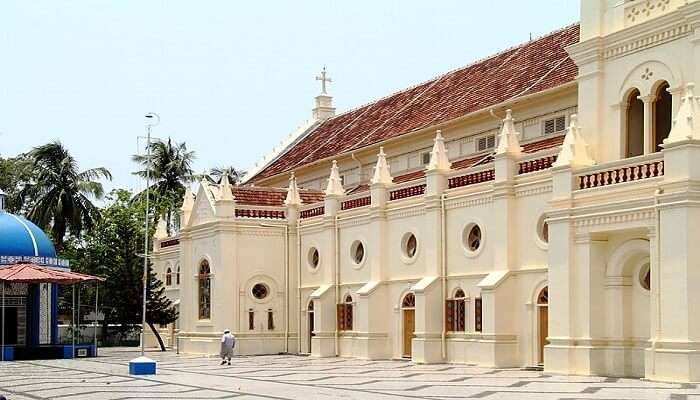
From 1505 to 1558
The Santa Cruz Cathedral Basilica’s history begins in the early 16th century after the Portuguese, led by Pedro Álvares Cabral, arrived in India in 1500. Seeking to dominate the spice trade, the Portuguese allied with the King of Cochin, Unni Goda Varma Tirumulpadu. In 1505, Dom Francisco de Almeida, the first Viceroy of Portuguese India, received permission from the King to build Fort Manuel (Fort Kochi) and two churches: the Santa Cruz Basilica and St. Francis Church.
Construction of the Santa Cruz Basilica began on May 4, 1505, on the eastern side of what is now Children’s Park in Fort Kochi. Named Santa Cruz (Holy Cross), it was built with stone and mortar, reflecting the Portuguese commitment to their religious and strategic presence in Cochin.
From 1558 to 1795
In 1558, Pope Paul IV elevated the Santa Cruz Church to a cathedral under the Archdiocese of Goa, extending its jurisdiction from the Cape of Good Hope to East Asia. Despite facing challenges, such as the Dutch destroying much of the Portuguese infrastructure in 1663, the cathedral was spared but repurposed as an arms storehouse. The British, who expelled the Dutch in 1795, later used the cathedral for military purposes and demolished it in 1806. However, some parts, like decorative granite pillars, were preserved as historical artefacts.
From 1886 till Today
After nearly a century of ruins, rebuilding of the Santa Cruz Cathedral began in the late 19th century under Bishop João Gomes Ferreira and was completed with significant input from Bishop Mateus de Oliveira Xavier. On 19 November 1905, Bishop Sebastião José Pereira consecrated the restored Cathedral.
The current Santa Cruz Cathedral Basilica, noted for its murals, stained glass, and ceiling paintings, was decorated by Italian artist Fr. Antonio Moscheni, who died before its inauguration. Elevated to a Basilica by Pope John Paul II in 1984, it remains a significant religious site, housing relics like the Holy Cross and serving as a pilgrimage destination.
The Architecture Of The Santa Cruz Cathedral Basilica
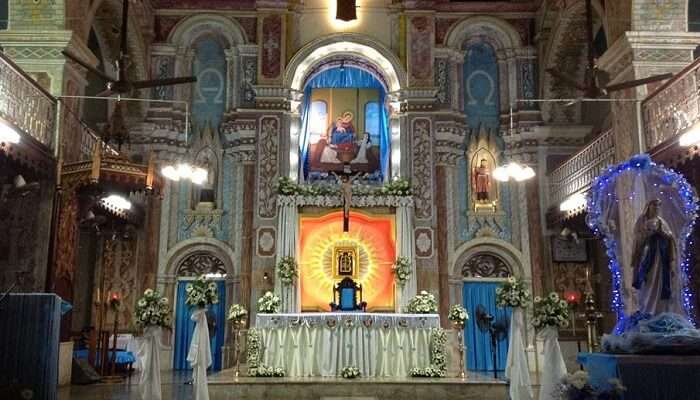
The Santa Cruz Cathedral Basilica showcases elements of Indo-European and Gothic architectural styles. The cathedral’s facade, with its intricate carvings and pointed arches, exemplifies this fusion. Inside the basilica, the craftsmanship of the pulpit and wooden panels stands out. The meticulously carved pulpit serves as a focal point during religious ceremonies. Adorned with delicate designs, the wooden panels add to the overall grandeur.
Exquisite Italian paintings enhance the interior. Brother Jesuit Fra Antonio Moscheni, an Italian painter from Bergamo, contributed significantly to the basilica’s artistic legacy. His masterpieces depict themes such as ‘The Passion and Death on the Cross’ and ‘The Last Supper.’ The Santa Cruz Basilica employs a palette of soft pastel shades, creating a serene and inviting atmosphere. The ceilings’ frescoes and murals narrate Christ’s life, while the stained-glass windows infuse the space with colourful light. Two towering spires grace the basilica’s exterior, visible even from a distance. These spires symbolise spiritual ascent and welcome all who approach. The arches within the cathedral evoke a sense of awe, framing the altar with elegance.
Related Post: Places To Visit Near Kochi Within 50 Kms
Santa Cruz Cathedral Basilica Timings, Fees, And Best Time To Visit

The Santa Cruz Cathedral Basilica in Kochi welcomes visitors from 9:00 AM to 1:00 PM and again from 3:00 PM to 5:00 PM daily. There is no entrance fee, although donations are appreciated. The best time to visit is from October to March, when the weather is pleasant, allowing for a comfortable exploration of this historical and architectural marvel.
How To Reach The Santa Cruz Cathedral Basilica?

Reaching the Santa Cruz Cathedral Basilica in Fort Kochi is convenient through various modes of transportation. They are as follows:
By Air: The closest international airport is Cochin International Airport, located at Nedumbassery, approximately 22 km from Kochi city. From the airport, travellers can easily find taxis or app-based cab services that provide direct transport to Fort Kochi, where the basilica is situated. The journey typically takes 45 minutes to an hour, depending on traffic conditions.
By Rail: Kochi has two main railway stations: Ernakulam Junction (South) and Ernakulam Town (North). Ernakulam Junction, located about 13 km from Fort Kochi, is the primary station offering frequent train services. Ernakulam Town, also known as Ernakulam North, provides additional train options. Travellers arriving by train can hire taxis or use local transport services to reach Fort Kochi, with the journey taking approximately 30-45 minutes, depending on traffic.
By Bus: Regular bus services operate from Ernakulam to Fort Kochi, covering the approximately 13 km distance in about an hour, subject to traffic conditions. The KSRTC Central Bus Station near Ernakulam Junction Railway Station is a major hub for buses heading to Fort Kochi. Buses are a cost-effective option for travellers exploring the area via public transport.
You May Also Like To Read: Subhash Bose Park
The Santa Cruz Cathedral Basilica is a testament to Kochi’s rich history and cultural fusion. Its stunning architecture, intricate artwork, and spiritual significance make it a must-visit destination for travellers and pilgrims alike. As you step outside this grand building, you’ll discover the lively and captivating atmosphere of Fort Kochi. It combines colonial charm with a modern vibe. Ready to experience the magic of Kochi for yourself? Don’t miss the opportunity to explore this historic gem and the many other wonders the city has to offer. Book your trip to Kochi today and journey through time, culture, and spirituality. Your adventure in this captivating coastal city awaits!
For our editorial codes of conduct and copyright disclaimer, please click here.
Cover Image Credit: Vis M for Wikimedia Commons
Frequently Asked Questions About Santa Cruz Cathedral Basilica
Why is Santa Cruz Basilica famous?
The Santa Cruz Cathedral Basilica, also known as “Kotta Palli” or “Kottepalli,” stands out for its captivating blend of Indo-European and Gothic architectural styles. As one of India’s finest churches, it draws visitors year-round due to its historical significance and artistic grandeur. Serving as the cathedral church of the Diocese of Cochin, it holds a special place in Kerala’s religious heritage.
Why is a cathedral called a basilica?
The title “basilica” is bestowed upon a cathedral by the Pope, signifying its importance and historical weight. In 1558, Pope Paul IV elevated the Santa Cruz Cathedral to the status of a cathedral. Later, in 1984, Pope John Paul II proclaimed it a basilica, recognising its exceptional significance.
What is the significance of the Basilica di Santa Cruz?
The Santa Cruz Cathedral Basilica in Fort Kochi is renowned for its Indo-European and Gothic architectural style. Originally built by the Portuguese in 1505, it was elevated to a cathedral in 1558. Despite destruction by the British in 1795, a new structure was commissioned in 1887. Today, it stands as one of India’s finest churches, attracting tourists year-round.
Who built the Santa Cruz Basilica Church?
The Portuguese initially built the Santa Cruz Cathedral Basilica after obtaining permission from the King of Cochin. Later, Bishop João Gomes Ferreira oversaw its reconstruction in 1887. This enduring structure reflects the unwavering dedication of Kerala’s Christian community.
How many basilica churches are there in Kerala?
Kerala boasts nine basilicas, including the Santa Cruz Cathedral. Each, with its unique history and charm, attracts visitors worldwide. They celebrate both faith and architectural marvels.
People Also Read:
Churches In Switzerland Churches In Mexico Churches In Ottawa

With a passion for exploring and travelling to the roads long forgotten, experience the world through enthralling stories and adventures. Join me as I share my experiences at some of the world’s most popular tourist destinations and quench that pestering curiosity with something exciting!




